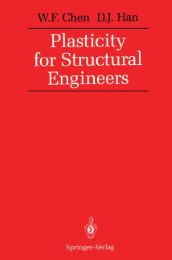-
Zusatztext
-
InhaltsangabeI Fundamentals.- 1 Introduction.- 1.1 Introduction.- 1.2 Historical Remarks.- 1.3 Plastic Behavior in Simple Tension and Compression.- 1.4 Modeling of Uniaxial Behavior in Plasticity.- 1.5 Index Notation.- 1.6 Summary.- References.- Problems.- Answers to Selected Problems.- 2 Yield and Failure Criteria.- 2.1 Stress.- 2.2 Yield Criteria Independent of Hydrostatic Pressure.- 2.3 Failure Criterion for Pressure-Dependent Materials.- 2.4 Anisotropic Failure/Yield Criteria.- 2.5 Summary.- References.- Problems.- Answers to Selected Problems.- 3 Elastic Stress-Strain Relations.- 3.1 Strain.- 3.2 Linear Elastic Isotropic Stress-Strain Relation-Hooke's Law.- 3.3 Nonlinear Elastic Isotropic Stress-Strain Relation.- 3.4 Principle of Virtual Work.- 3.5 Drucker's Stability Postulate.- 3.6 Normality, Convexity, and Uniqueness for an Elastic Solid.- 3.7 Incremental Stress-Strain Relations.- 3.8 Summary.- References.- Problems.- Answers to Selected Problems.- II Plastic Stress-Strain Relations.- 4 Stress-Strain Relations for Perfectly Plastic Materials.- 4.1 Introduction.- 4.2 Plastic Potential and Flow Rule.- 4.3 Flow Rule Associated with von Mises Yield Function.- 4.4 Flow Rule Associated with Tresca Yield Function.- 4.5 Flow Rule Associated with Mohr-Coulomb Yield Function.- 4.6 Convexity, Normality, and Uniqueness for Elastic-Perfectly Plastic Materials.- 4.7 A Simple Elastic-Plastic Problem: The Expansion of a Thick-Walled Cylinder.- 4.8 Incremental Stress-Strain Relationships.- 4.9 Prandtl-Reuss Material Model (J2 Theory).- 4.10 Drucker-Prager Material Model.- 4.11 General Isotropic Material.- References.- Problems.- Answers to Selected Problems.- 5 Stress-Strain Relations for Work-Hardening Materials.- 5.1 Introduction.- 5.2 Deformation Theory of Plasticity.- 5.3 Loading Surface and Hardening Rules.- 5.4 Flow Rule and Drucker's Stability Postulate.- 5.5 Effective Stress and Effective Strain.- 5.6 Illustrative Examples.- 5.7 Incremental Stress-Strain Relationships.- References.- Problems.- Answers to Selected Problems.- III Metal Plasticity.- 6 Implementation in Metals.- 6.1 Introduction.- 6.2 Formulation of the Elastic-Plastic Matrix.- 6.3 Finite-Element Formulation.- 6.4 Numerical Algorithms for Solving Nonlinear Equations.- 6.5 Numerical Implementation of the Elastic-Plastic Incremental Constitutive Relations.- 6.6 Bounding Surface Theory.- 6.7 Extension to Anisotropic Case.- References.- IV Concrete Plasticity.- 7 Implementation in Concretes.- 7.1 Introduction.- 7.2 Failure Criteria.- 7.3 Plasticity Modeling: Hardening Behavior.- 7.4 Plasticity Modeling: Softening Behavior.- References.- V Limit Analysis.- 8 General Theorems of Limit Analysis and Their Applications.- 8.1 Introduction.- 8.2 Theorems of Limit Analysis.- 8.3 Applications of the General Theorems.- 8.4 Discontinuous Stress Fields.- 8.5 Basic Techniques in Applications of the Upper-Bound Method.- 8.6 Example Problems in Plane Stress, Plane Strain, and 3-D.- References.- Problems.- Answers to Selected Problems.- 9 Limit Analysis of Engineering Structures.- 9.1 Introduction.- 9.2 Bending of Beams and Frames.- 9.3 Combined Axial and Bending Forces in Frames and Arches.- 9.4 Effect of Shear Force.- 9.5 Limit Analysis of Plates.- 9.6 Limit Analysis of Plates on Elastic Foundations.- 9.7 Limit Analysis of Shells.- References.- Problems.- Answers to Selected Problems.
-
Detailansicht
Plasticity for Structural Engineers
ISBN/EAN: 9781461283805
Umbreit-Nr.: 4151455
Sprache:
Englisch
Umfang: XIII, 606 S.
Format in cm:
Einband:
kartoniertes Buch
Erschienen am 22.10.2011
Auflage: 1/1988


